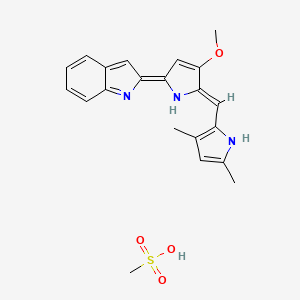Obatoclax mesylate
- Obatoclax mesylate
- 803712-79-0
- Obatoclax mesilate
- Obatoclax (Mesylate)
- 2-(2-((3,5-Dimethyl-1H-pyrrol-2-yl)methylene)-3-methoxy-2H-pyrrol-5-yl)-1H-indole methanesulfonate
- Create:2007-08-20
- Modify:2025-01-11

- 1H-indole, 2-(2-((3,5-dimethyl-1H-pyrrol-2-yl)methylene)-3-methoxy-2H-pyrrol-5-yl)-
- 2-((2Z)-2-((3,5-Dimethyl-1H-pyrrol-2-yl)methylene)-3-methoxy-2H-pyrrol-5-yl)-1H-indole methanesulfonate (1:1)
- 2-(2-((3,5-dimethyl-1H-pyrrol-2-yl)methylene)-3-methoxy-2H-pyrrol-5-yl)-1H-indole
- 2-(2-((3,5-Dimethyl-1H-pyrrol-2-yl)methylene)-3-methoxy-2H-pyrrol-5-yl)-1H-indole methanesulfonate
- GX 15-070
- GX-15-070
- GX015-070
- GX15-070
- obatoclax
- obatoclax mesylate
- Obatoclax mesylate
- 803712-79-0
- Obatoclax mesilate
- Obatoclax (Mesylate)
- 2-(2-((3,5-Dimethyl-1H-pyrrol-2-yl)methylene)-3-methoxy-2H-pyrrol-5-yl)-1H-indole methanesulfonate
- CHEMBL4777255
- Obatoclax mesylate (GX15-070)
- GX-15-070MS
- (2Z)-2-[(5Z)-5-[(3,5-dimethyl-1H-pyrrol-2-yl)methylidene]-4-methoxypyrrol-2-ylidene]indole;methanesulfonic acid
- GX15-070MS
- Obatoclax mesylate [USAN]
- MFCD18074508
- CHEMBL2107358
- EX-A333
- OBATOCLAX MESILATE [WHO-DD]
- BDBM50547622
- NSC729280
- CCG-264798
- CS-0133
- NSC-729280
- (Z)-2-(2-((3,5-dimethyl-1H-pyrrol-2-yl)methylene)-3-methoxy-2H-pyrrol-5-yl)-1H-indole methanesulfonate
- AC-32080
- HY-10969
- PD087642
- J-505411
- 1H-INDOLE, 2-(2-((3,5-DIMETHYL-1H-PYRROL-2-YL)METHYLENE)-3-METHOXY-2H-PYRROL-5-YL), MONOMETHANESULFONATE
- 1H-INDOLE, 2-(2-((3,5-DIMETHYL-1H-PYRROL-2-YL)METHYLENE)-3-METHOXY-2H-PYRROL-5-YL), MONOMETHANESULPHONATE
- 2-(2-((3,5-DIMETHYL-1H-PYRROL-2-YL)METHYLIDENE)-3-METHOXY-2H-PYRROL-5-YL)-1H-INDOLE MONOMETHANESULPHONATE
- 2-[2-[(3,5-Dimethyl-1H-pyrrol-2-yl)methylidene]-3-methoxy-2H-pyrrol-5-yl]-1H-indole monomethanesulfonate
- 3-Carboxy-2,5-dimethyl-1H-pyrrol-2-ylmethylene)-5-(1H-indol-2-yl)-3-methoxy-2H-pyrrolium, mesylate salt

H301 (100%): Toxic if swallowed [Danger Acute toxicity, oral]
H315 (100%): Causes skin irritation [Warning Skin corrosion/irritation]
P264, P270, P280, P301+P316, P302+P352, P321, P330, P332+P317, P362+P364, P405, and P501
(The corresponding statement to each P-code can be found at the GHS Classification page.)
Aggregated GHS information provided per 38 reports by companies from 1 notifications to the ECHA C&L Inventory. Each notification may be associated with multiple companies.
Information may vary between notifications depending on impurities, additives, and other factors. The percentage value in parenthesis indicates the notified classification ratio from companies that provide hazard codes. Only hazard codes with percentage values above 10% are shown.
Acute Tox. 3 (100%)
Skin Irrit. 2 (100%)
- ChEMBLLICENSEAccess to the web interface of ChEMBL is made under the EBI's Terms of Use (http://www.ebi.ac.uk/Information/termsofuse.html). The ChEMBL data is made available on a Creative Commons Attribution-Share Alike 3.0 Unported License (http://creativecommons.org/licenses/by-sa/3.0/).http://www.ebi.ac.uk/Information/termsofuse.htmlChEMBL Protein Target Treehttps://www.ebi.ac.uk/chembl/g/#browse/targets
- Drug Gene Interaction database (DGIdb)LICENSEThe data used in DGIdb is all open access and where possible made available as raw data dumps in the downloads section.http://www.dgidb.org/downloadsOBATOCLAX MESYLATEhttps://www.dgidb.org/drugs/ncit:C62771
- ClinicalTrials.govLICENSEThe ClinicalTrials.gov data carry an international copyright outside the United States and its Territories or Possessions. Some ClinicalTrials.gov data may be subject to the copyright of third parties; you should consult these entities for any additional terms of use.https://clinicaltrials.gov/ct2/about-site/terms-conditions#Use
- DTP/NCILICENSEUnless otherwise indicated, all text within NCI products is free of copyright and may be reused without our permission. Credit the National Cancer Institute as the source.https://www.cancer.gov/policies/copyright-reuse
- EU Clinical Trials Register
- European Chemicals Agency (ECHA)LICENSEUse of the information, documents and data from the ECHA website is subject to the terms and conditions of this Legal Notice, and subject to other binding limitations provided for under applicable law, the information, documents and data made available on the ECHA website may be reproduced, distributed and/or used, totally or in part, for non-commercial purposes provided that ECHA is acknowledged as the source: "Source: European Chemicals Agency, http://echa.europa.eu/". Such acknowledgement must be included in each copy of the material. ECHA permits and encourages organisations and individuals to create links to the ECHA website under the following cumulative conditions: Links can only be made to webpages that provide a link to the Legal Notice page.https://echa.europa.eu/web/guest/legal-notice804-325-6https://echa.europa.eu/information-on-chemicals/cl-inventory-database/-/discli/details/237615[No public or meaningful name is available]https://echa.europa.eu/substance-information/-/substanceinfo/100.231.050
- FDA Global Substance Registration System (GSRS)LICENSEUnless otherwise noted, the contents of the FDA website (www.fda.gov), both text and graphics, are not copyrighted. They are in the public domain and may be republished, reprinted and otherwise used freely by anyone without the need to obtain permission from FDA. Credit to the U.S. Food and Drug Administration as the source is appreciated but not required.https://www.fda.gov/about-fda/about-website/website-policies#linkingOBATOCLAX MESYLATEhttps://gsrs.ncats.nih.gov/ginas/app/beta/substances/39200FJ43J
- NCI Thesaurus (NCIt)LICENSEUnless otherwise indicated, all text within NCI products is free of copyright and may be reused without our permission. Credit the National Cancer Institute as the source.https://www.cancer.gov/policies/copyright-reuseNCI Thesaurushttps://ncit.nci.nih.gov
- Open TargetsLICENSEDatasets generated by the Open Targets Platform are freely available for download.https://platform-docs.opentargets.org/licenceOBATOCLAX MESYLATEhttps://platform.opentargets.org/drug/CHEMBL2107358
- PubChem
- Medical Subject Headings (MeSH)LICENSEWorks produced by the U.S. government are not subject to copyright protection in the United States. Any such works found on National Library of Medicine (NLM) Web sites may be freely used or reproduced without permission in the U.S.https://www.nlm.nih.gov/copyright.htmlEnzyme Inhibitorshttps://www.ncbi.nlm.nih.gov/mesh/68004791
- GHS Classification (UNECE)GHS Classification Treehttp://www.unece.org/trans/danger/publi/ghs/ghs_welcome_e.html
- MolGenieMolGenie Organic Chemistry Ontologyhttps://github.com/MolGenie/ontology/


 CID 11404337 (Obatoclax)
CID 11404337 (Obatoclax) CID 6395 (Methanesulfonic Acid)
CID 6395 (Methanesulfonic Acid)